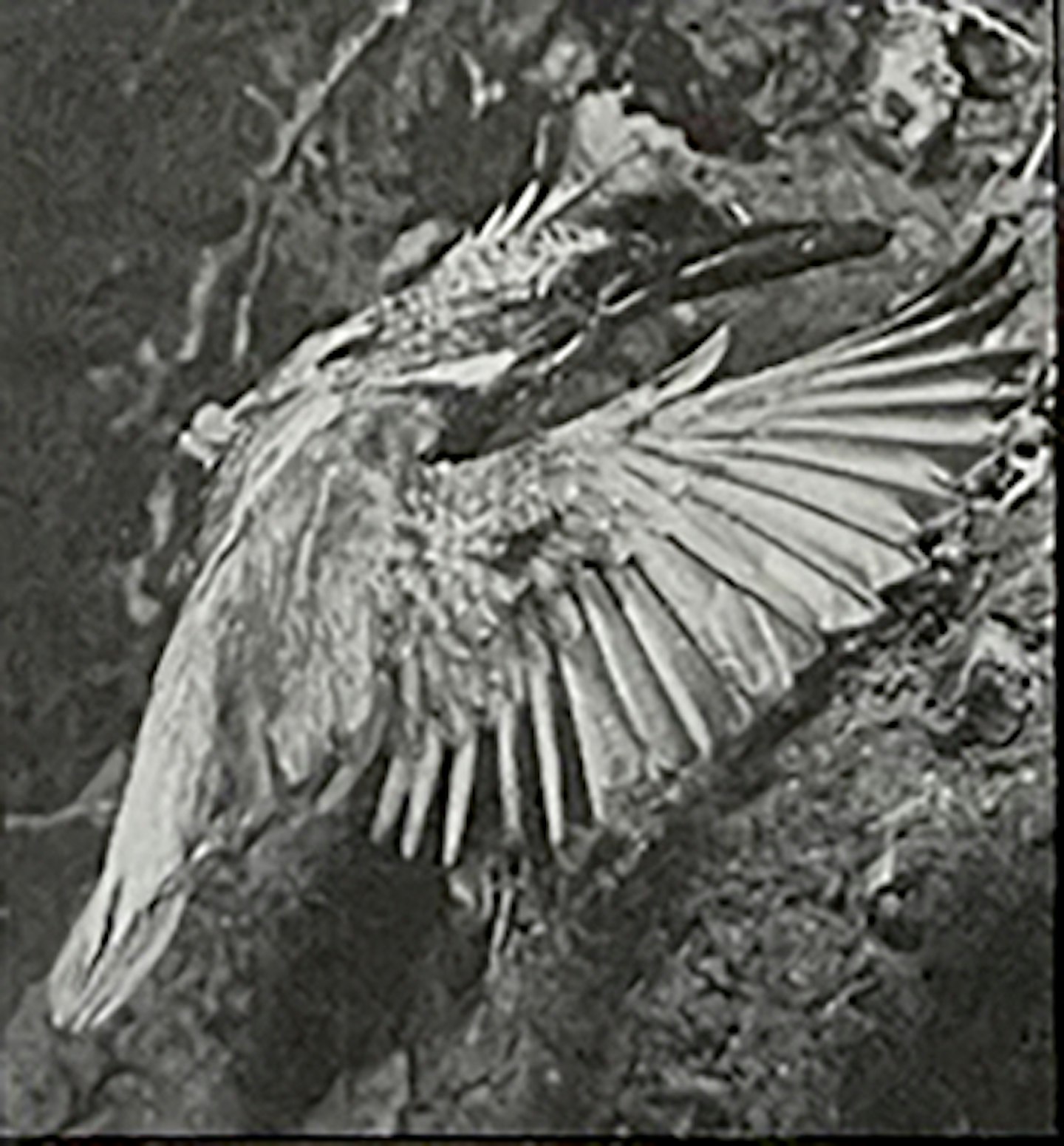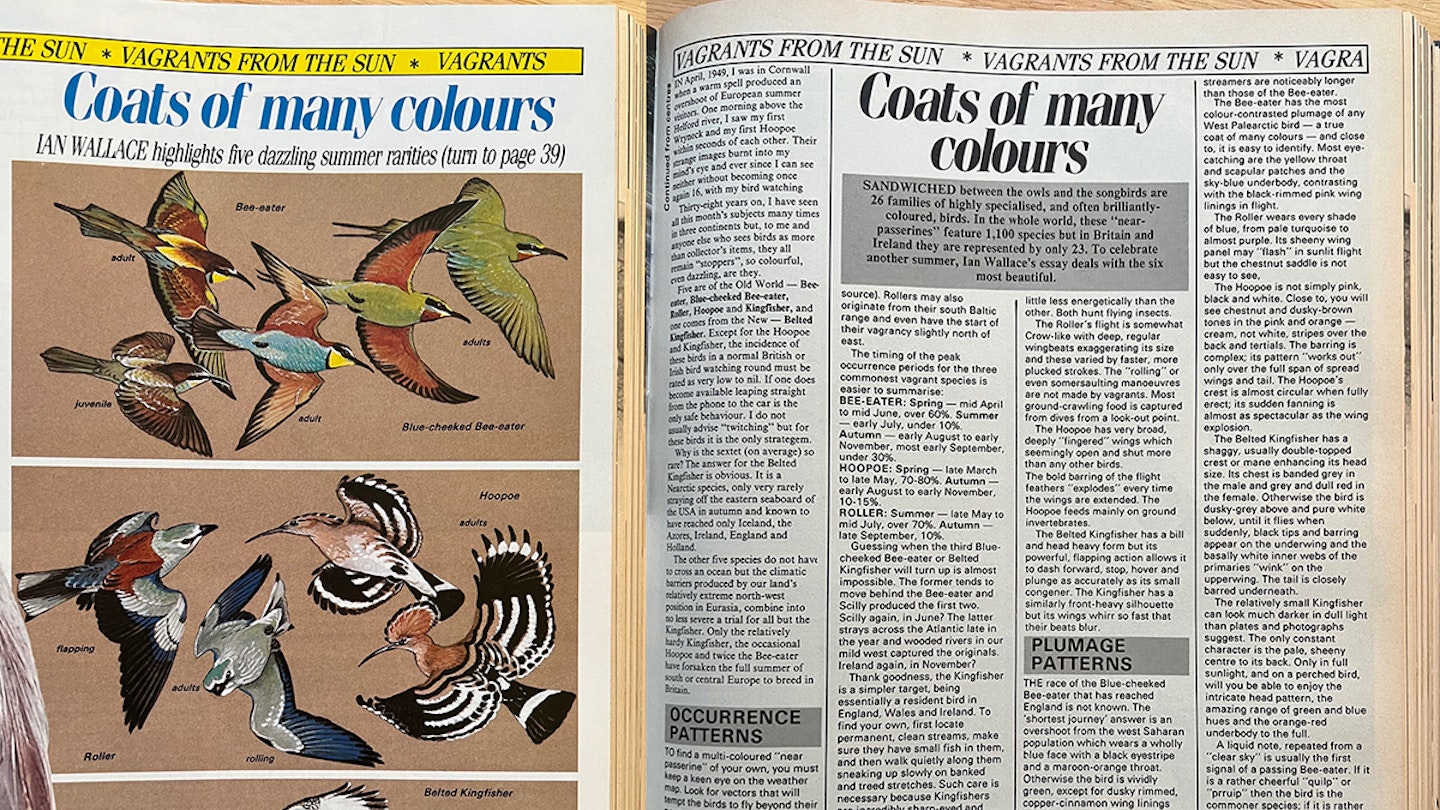Coats of many colours
May 1987
Sandwiched between the owls and the songbirds are 26 families of highly specialised, and often brilliantly- coloured, birds. In the whole world, these ‘near- passerines’ feature 1,100 species but in Britain and Ireland they are represented by only 23. To celebrate another summer, Ian Wallace's essay deals with the six most beautiful.
In April, 1949, I was in Cornwall when a warm spell produced an overshoot of European summer visitors. One morning above the Helford river, I saw my first wryneck and my first Hoopoe within seconds of each other. Their strange images burnt into my mind's eye and ever since I can see colours neither without becoming once Con again 16, with my birdwatching.
Thirty-eight years on, I have seen all this month's subjects many times in three continents but, to me and anyone else who sees birds as more than collector's items, they all remain ‘stoppers’, so colourful, even dazzling, are they.
Five are of the Old World: Bee-eater, Blue-cheeked Bee-eater, Roller, Hoopoe and Kingfisher; and one comes from the New: Belted Kingfisher. Except for the Hoopoe and Kingfisher, the incidence of these birds in a normal British or Irish birdwatching round must be rated as very low to nil. If one does become available leaping straight from the phone to the car is the only safe behaviour. I do not usually advise ‘twitching’ but for these birds it is the only stratagem.
Why is the sextet (on average) so rare? The answer for the Belted Kingfisher is obvious. It is a Nearctic species, only very rarely straying off the eastern seaboard of the USA in autumn and known to have reached only Iceland, the Azores, Ireland, England and Holland.
The other five species do not have to cross an ocean but the climatic barriers produced by our land's relatively extreme north-west position in Eurasia, combine into no less severe a trial for all but the Kingfisher. Only the relatively hardy Kingfisher, the occasional Hoopoe and twice the Bee-eater have forsaken the full summer of south or central Europe to breed in Britain.
Occurrence patterns
To find a multi-coloured ‘near passerine’ of your own, you must keep a keen eye on the weather map. Look for vectors that will tempt the birds to fly beyond their normal limits, or will sweep them off their standard migration routes. The odds are that as do the rarer Herons, spring Hoopoes come from a narrow southerly bearing and some Rollers and Bee-eaters follow them. It may even be that such birds were coasting along north-west Africa and Portugal and might have spent far more over sea than land during their overshoot.
The summer and autumn vectors are less easy to explain but sometimes they clearly link into drifts of Marsh Terns across Europe and even to occurrences of Rose-coloured Starlings (and thus a really far-off south-east source) Rollers may also originate from their south Baltic range and even have the start of their vagrancy slightly north of east.
The timing of the peak occurrence periods for the three commonest vagrant species is easier to summarise:
Bee-eater: Spring mid April to mid June, over 60%. Summer - early July, under 10%. Autumn - early August to early November, most early September, under 30%
Hoopoe: Spring - late March to late May, 70-80%. Autumn - early August to early November, 10-15%
Roller: Summer - late May to mid July, over 70%. Autumn - late September, 10%
Guessing when the third Blue- cheeked Bee-eater or Belted Kingfisher will turn up is almost impossible. The former tends to move behind the Bee-eater and Scilly produced the first two. Scilly again, in June? The latter strays across the Atlantic late in the year and wooded rivers in our mild west captured the originals. Ireland again, in November?
Thank goodness, the Kingfisher is a simpler target, being essentially a resident bird in England, Wales and Ireland. To find your own, first locate permanent, clean streams, make sure they have small fish in them, and then walk quietly along them sneaking up slowly on banked and treed stretches. Such care is necessary because Kingfishers are incredibly sharp-eyed and often flit away from disturbance.
Flight action and behaviour
Many birds are credited with extraordinary powers of flight but the Bee-eaters have real claim to mastery of the air. Their strong, rather Hirundine-like forms, allow them instantly to shoot off a perch and cleave the air, with quick bursts of powerful wing beats propelling them forward. These are varied by graceful swoops and turns on noticeably level, outstretched wings. On average, the Blue-cheeked flies a little less energetically than the other. Both hunt flying insects.
The Roller's flight is somewhat Crow-like with deep, regular wingbeats exaggerating its size and these varied by faster, more plucked strokes. The ‘rolling’ or even somersaulting manoeuvres are not made by vagrants. Most ground-crawling food is captured from dives from a look-out point.
The Hoopoe has very broad, deeply ‘fingered’ wings which seemingly open and shut more than any other birds. The bold barring of the flight feathers ‘explodes’ every time the wings are extended. The Hoopoe feeds mainly on ground invertebrates.
The Belted Kingfisher has a bill and head heavy form but its powerful, flapping action allows it to dash forward, stop, hover and plunge as accurately as its small congener. The Kingfisher has a similarly front-heavy silhouette but its wings whirr so fast that their beats blur.
Plumage patterns
The race of the Blue-cheeked Bee-eater that has reached England is not known. The ‘shortest journey’ answer is an overshoot from the west Saharan population which wears a wholly blue face with a black eyestripe and a maroon-orange throat. Otherwise the bird is vividly green, except for dusky rimmed, copper-cinnamon wing linings which show well. The adult's tail streamers are noticeably longer than those of the Bee-eater.
The Bee-eater has the most colour-contrasted plumage of any West Palearctic bird - a true coat of many colours - and close to, it is easy to identify. Most eye- catching are the yellow throat and scapular patches and the sky-blue underbody, contrasting with the black-rimmed pink wing linings in flight.
The Roller wears every shade of blue, from pale turquoise to almost purple. Its sheeny wing panel may ‘flash’ in sunlit flight but the chestnut saddle is not easy to see.
The Hoopoe is not simply pink, black and white. Close to, you will see chestnut and dusky-brown tones in the pink and orange – cream, not white, stripes over the back and tertials. The barring is complex; its pattern ‘works out’ only over the full span of spread wings and tail. The Hoopoe's crest is almost circular when fully erect; its sudden fanning is almost as spectacular as the wing explosion.
The Belted Kingfisher has a shaggy, usually double-topped crest or mane enhancing its head size. Its chest is banded grey in the male and grey and dull red in the female. Otherwise the bird is dusky-grey above and pure white below, until it flies when suddenly, black tips and barring appear on the underwing and the basally white inner webs of the primaries ‘wink’ on the upperwing. The tail is closely barred underneath.
The relatively small Kingfisher can look much darker in dull light than plates and photographs suggest. The only constant character is the pale, sheeny centre to its back. Only in full sunlight, and on a perched bird, will you be able to enjoy the intricate head pattern, the amazing range of green and blue hues and the orange-red underbody to the full.
Sound clues
A liquid note, repeated from a ‘clear sky’ is usually the first signal of a passing Bee-eater. If it is a rather cheerful ‘quilp’ or ‘prruip’ then the bird is the commoner species; if it is rather thin and throaty ‘greep’ or ‘treet’ then the owner has blue cheeks.
If another disembodied call can be written ‘rak’ or ‘cruk’ (singly or in a series) then the bird may not be a crow, it could be a Roller. Unfortunately, neither vagrant Rollers nor Hoopoes call much. If you do hear a soft ‘poo- poo-poo’ from the latter, then you have a male intent on finding a mate.

Moving at speed, Kingfishers can often appear darker than as shown in field guides.
The Belted Kingfisher shatters ears with a loud machine gun- like rattle which is quite unmistakable. The Kingfisher utters a shrill, penetrating ‘ca(r)ee’
2020s Update
There have been 13 accepted records of Blue-cheeked Bee-eater in the UK, with most in the spring and summer; and exception being a curious outlier of an individual being seen by one observer in Peterborough, Cambridgeshire, on 17 September 1982.
There have been just five accepted records of Belted Kingfisher in the UK.But this does not include the bird currently present along the River Darwen and nearby waterways, mainly at Samlesbury, Lancashire
